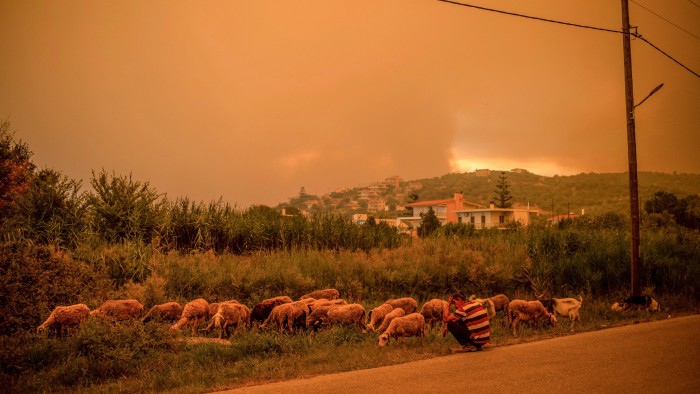Backing biodiversity to save ourselves

Roula Khalaf, Editor of the FT, selects her favourite stories in this weekly newsletter.
It is often believed that the financial sector can survive any crisis and that investors always find a way to bounce back and make more money. It took about four years for the markets to recover from the 2008 financial crisis, and only a few months to return to pre-pandemic levels.
The biodiversity crisis will be different. The markets took a quarter of a century to recover from the Great Depression in 1929. They will probably take a similar time to rebound once the mass extinction of species is fully underway by 2030. Biodiversity loss, set to be one of the largest environmental crises of all times, will collapse economies and societies. If the financial sector wants to survive it must move now, fast and at scale.
Protecting biodiversity matters to economies. Ecosystem “services” such as crop pollination, water purification and carbon sequestration are vital. The results of the heat dome — hot air trapped by the atmosphere — that destroyed crops and forests and caused devastating floods this summer were just initial warnings of the economic damage to come.
This year Swiss Re, the reinsurance group, re-examined estimates of the value of biodiversity at $33tn a year — close to the combined GDP of the US and China. It said a fifth of countries had fragile ecosystems covering at least 30 per cent of their land area and more than half of global GDP was dependent on biodiversity and ecosystem services. Swiss Re estimated that large economies would lose about 10 per cent of GDP in the coming three decades.
The most recent and exhaustive report from the Intergovernmental Science-Policy Platform on Biodiversity and Ecosystem Services paints a grim picture. One million of 8m species on earth are threatened with extinction, most within decades. Between 1970 and 2016, nearly 21,000 monitored populations of 4,392 vertebrate species declined by an average of over 68 per cent, according to WWF (Worldwide Fund for Nature). Scientists expect the biodiversity crisis to create greater devastation for societies than climate change, to which it is intimately related.
To prepare for this impact on the planet and markets, 55 financial institutions worldwide signed the Finance for Biodiversity Pledge, committing them to protection and restoration through their activities and investments.
But traditional biodiversity funding models lack the capital to respond effectively. If we are to meet targets on climate change, biodiversity and land degradation, we must close a $4.1tn financing gap by 2050, according to the UN. The current investments in nature-based solutions amount to $133bn, mostly from public sources.
Conservationists are now imploring investors to step in. The Convention on Biological Diversity recently released a new guide to mobilise financial institutions. Conservation finance — raising capital to support land, water and resource conservation — is an emerging field that could help.
But protecting biodiversity is complex and investors will not succeed alone. They need to partner with others, including conservationists, indigenous peoples and academics. Only innovative financial instruments designed in an interdisciplinary and collaborative fashion will effectively channel capital towards protecting ecosystems.
While indigenous peoples represent 5 per cent of the world’s population, they are the stewards of 80 per cent of biodiversity on earth, according to the World Bank. Yet the financial sector rarely draws on indigenous knowledge.
It is estimated that 30 per cent of land and water must be conserved, protected or restored if the world is to become climate resilient. Conservation impact bonds create the financial structure for necessary investments to become attractive to the private market by providing some returns.
The Canadian Deshkan Ziibi Conservation Impact bond (DZ-CIB), which draws on both indigenous and western knowledge, is one example of the type of community-based participatory research project that the financial sector could support. It is a financial instrument that aims to reconcile peoples and ecosystems by fostering healthy landscapes with nature-based solutions that support indigenous leadership.
The bond incentivises investments in high-quality natural infrastructure. Like a social impact bond, it has facilitators — in this case a coalition of conservation organisations — as well as investors and backers who pay out if aims are achieved. In its first phase up to 2023, a social finance firm provided upfront investment, and a multinational company acted as the outcome funder, paying the principal and return if impact targets are met.
Climate Capital

Where climate change meets business, markets and politics. Explore the FT’s coverage here.
Are you curious about the FT’s environmental sustainability commitments? Find out more about our science-based targets here
Impact metrics were decided with partners including the research team, habitat partners, indigenous communities and investors. The result is a self-sustaining cycle of improved natural infrastructure and ecosystem health.
Incentive schemes related to improved biodiversity outcomes are another approach. An example is the launch this year by the Zoological Society of London (ZSL) and WWF of a $45m security that pays investors financial returns linked to conservationists’ ability to save the rhinoceros.
Investors hold considerable power in influencing how society operates. They can support and drive the transformational changes required to address the biodiversity crisis. But to do so, they need to engage now.
Diane-Laure Arjaliès

An associate professor at Ivey Business School at Western University, Canada and winner of the 2021 teaching recognition award for excellence in sustainable finance education, awarded by the FT and the Impact and Sustainable Finance Faculty Consortium.
Comments